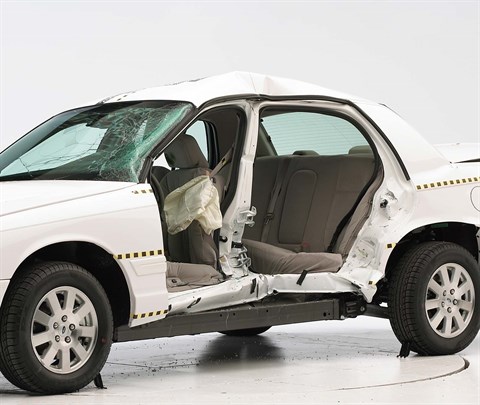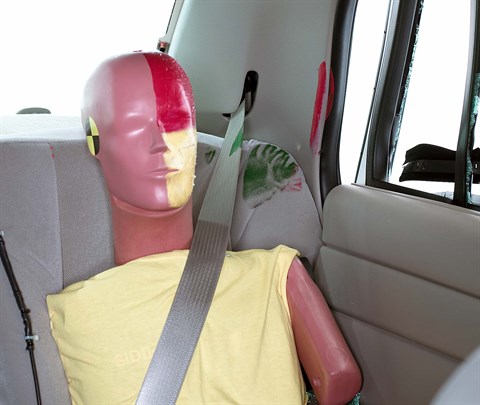Moderate overlap front: original test
Rating applies to 2003-11 models built after May 2003
Tested vehicle: 2003 Lincoln Town Car Premium Signature 4-door
The Lincoln Town Car, Ford Crown Victoria, and Mercury Grand Marquis were re-engineered for the 2003 model year. Beginning with 2008 models, the Ford Crown Victoria was sold when new only to fleets. The Mercury Grand Marquis was discontinued after the 2010 model year.
The Insurance Institute for Highway Safety has evaluated the crashworthiness of a 2003 Town Car in two 40 mph frontal offset crash tests into deformable barriers. In the first test, a high acceleration occurred when the dummy's head rebounded against the B-pillar, indicating a possibility of head injury. This led Lincoln to modify the frontal airbag deployment characteristics on models produced after May 2003 (note: information about when a specific vehicle was manufactured is on the certification label typically affixed to the car on or near the driver door).
The Institute tested a second Town Car with the modified airbags, and all head injury measures were low. Ratings of the Town Car listed here are from the second test.
| Evaluation criteria | Rating |
|---|---|
| Overall evaluation | |
| Structure and safety cage | |
| Driver injury measures | |
| Head/neck | |
| Chest | |
| Leg/foot, left | |
| Leg/foot, right | |
| Driver restraints and dummy kinematics Dummy movement was reasonably well controlled in the second test. During rebound, the top of the head hit the roof rail and adjacent window frame between the A- and B-pillars. As in the first test, the driver's seat tipped toward the door. | |

Action shot taken during the second of two frontal offset crash tests.

The dummy's position in relation to the steering wheel and instrument panel after both crash tests indicates that the driver's survival space was maintained well (second test shown).

Smeared red greasepaint indicates where the dummy's head hit the B-pillar during rebound in the first test, producing a high head acceleration.

Forces on the lower left leg were high enough to indicate the possibility of injury in both tests (second test shown).
Side: original test
Rating applies to 2009-11 models
Tested vehicle: 2007 Ford Crown Victoria LX 4-door with optional front seat-mounted combination head and torso airbags
The Ford Crown Victoria and Mercury Grand Marquis were re-engineered for the 2003 model year. Beginning with 2007 models built after July 2006, design changes were made to the optional side airbags and door trim to improve occupant protection in side impact crashes (note: information about when a specific vehicle was manufactured is on the certification label typically affixed to the car on or near the driver door). Beginning with 2008 models, the Ford Crown Victoria was sold when new only to fleets. Beginning with 2009 models of the Crown Victoria and Grand Marquis, side airbags were made standard. The Grand Marquis was discontinued after the 2010 model year.
Two tests of the Crown Victoria were conducted, one a 2007 model with the design changes and equipped with optional side airbags, and the other a 2006 model without side airbags. These vehicles are rated separately, except that the structural ratings and rear passenger injury and head protection ratings for both vehicles are based on both tests.
| Evaluation criteria | Rating |
|---|---|
| Overall evaluation | |
| Structure and safety cage | |
| Driver injury measures | |
| Head/neck | |
| Torso | |
| Pelvis/leg | |
| Driver head protection | |
| Rear passenger injury measures | |
| Head/neck | |
| Torso | |
| Pelvis/leg | |
| Rear passenger head protection The dummy's head was hit by the pillar behind the rear passenger door. This pillar is required by federal standard to provide some protection for occupants' heads. | |

View of the vehicle and barrier just after the crash test.

View of the vehicle after the crash with doors removed, showing the side airbag and damage to the occupant compartment.

Smeared greasepaint shows where the driver dummy's head was protected from being hit by hard structures by the side airbag.

Smeared red greasepaint shows where the rear passenger dummy’s head was hit by the pillar behind the rear passenger door.
Head restraints & seats
Seat type: Seats with adjustable lumbar
| Overall evaluation | |
|---|---|
| Dynamic rating | |
| Seat/head restraint geometry |
About the head restraint & seat test
Currently, IIHS tests apply only to front seats.
